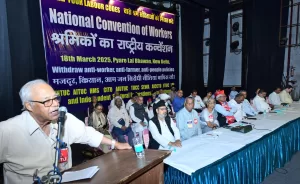“If Lord Ram was alive today, I would have sent him to jail under section 302 of the IPC for the murder of Rishi Shambuk. And if Lord Krishna lived today, I would have sent him to jail under a case for sexual harassment of women.”
Last month, when Vikram Harijan, an assistant professor who teaches ancient and medieval history at the Allahabad University, posted this provocatively-worded tweet on X (formerly Twitter), it triggered a barrage of outrage against him.
Harijan belongs to a Dalit community.
Section 302 of the Indian Penal Code deals with murder.
On October 22, Prayagraj police lodged an FIR against him for the tweet, accusing him of regularly insulting Hindu deities through “indecent and hateful comments.” The police acted on a complaint by some right-wing groups, including the Bajrang Dal, and booked Harijan under Sections 153A (promoting enmity between groups) and 295A (deliberate and malicious act to outrage religious feelings) of the IPC and Section 66 of the Information Technology Act.
“Every other day, Harijan insults Hindu deities and this has created anger among students and also hurt the Hindu society,” said Shubham, a Bajrang Dal activist, in the FIR.
Harijan approached the Allahabad high court pleading that the FIR against him be quashed. During the hearing of the petition, however, he sought protection under Section 41-A of the CrPC, which stipulates that a person must be served notice by the police prior to his or her arrest.
On November 8, a division bench of Justices Ashwani Kumar Mishra and Syed Aftab Husain Rizvi ruled that since the FIR prima facie disclosed commissioning of cognisable offence, it could not be quashed. However, the court directed the state authorities to ensure compliance of Section 41-A of CrPC if its provisions were attracted in the case.
While Harijan received legal relief against arbitrary arrest, his troubles did not end there.
University serves notice
On Tuesday, November 21, the university served him a show cause notice to submit his explanation for “posting outrageous comments against Hindu deities and culture” on social media platforms within seven working days.
This was only the latest controversy that the outspoken Dalit professor, knowing for unabashedly voicing his critique of the caste system and dogmas of Hindu religion, has found himself in the last four years. He has invited the wrath of both right-wing groups as well as the university administration through his blunt articulation.
Since 2019, the central varsity has served him notice and right-wing groups have registered complaints against him for targeting the Hindu faith on at least two other occasions. For the university and his critics, he is a provocateur. But for Harijan, he is expressing his freedom to rationally critique social practices and ideas linked to caste, a subject he feels strongly about.
Talking to The Wire, Harijan said he used the references to the Hindu deities in his quest to “develop rationality” among students and demonstrate to them the difference between modern democracy and autocratic states in ancient, medieval and modern periods.
“Democracy means a constitutional life based on rule of law. In that context, I stated this example that had these deities committed these acts in these times, what would have been the response to them. It was an emotional step towards teaching rationality to students,” he said.
Shambuk and the rage of the years
Not restricted to academic expression, the motivation to use these references also stems from his “internal rage” on the issue of caste discrimination and his lived experiences as a Dalit. The story of Shambuk, a reference to which has landed him in a soup, has often been used by scholars to illustrate caste hierarchy and discrimination in the Ramayana. B.R. Ambedkar refers to it in his seminal work Annihilation of Caste and also details it in the Riddles of Hinduism, which was posthumously published.
The story goes that when Ram was ruling Ayodhya as a king, a Brahmin man comes to him, weeping, with his dead son in his arms. The Brahmin concludes that his son died because the king may have committed a sin. A sage informs Ram that the Brahmin’s son died because a Shudra man in the kingdom was practising penance, in violation of the dharma. Ram goes to the said Shudra ascetic, Shambuk, who informs the king that he was performing penance to find a place in heaven. Rama punishes the Shudra for his transgression by cutting off his head.
Ambedkar writes that to blame Ram for wantonly killing Shambuk was to misunderstand the situation. As a king, Ram was bound to maintain the Chaturvarna (four-tier caste system with low caste Shudras at the bottom), which was the basis of Ram Raj, said Ambedkar. Therefore, it was his duty to kill Shambuk for transgressing his class and wanting to be a Brahmin.
Dravidian movement social reformer E. V. Ramasamy “Periyar” had also expressed outrage over Ram’s treatment of Shudras. In Many Ramayanas: The Diversity of a Narrative Tradition in South Asia, author Paula Richman writes that Periyar summarised the killing of Shambuk and extrapolated from it to present-day South India.
Richman wrote: “’If there were kings like Rama now, what would be the fate of those people called Sudras?’ he asks, implying that Sudras would never be safe from murder if such a king still ruled.”
Through references to Ambedkar and Periyar’s writings on the subject, Harijan defends the context of his controversial tweet. “If we don’t discuss all these, how will we teach the Annihilation of Caste to students? How will we bring an end to religious and caste rigidities? If I am wrong, then even Ambedkar, Periyar and Jyotiba Phule are wrong. They all raised such questions. What I have said is nothing new,” he said.
Though Harijan later deleted his tweet on Ram and Krishna, he said he stands by the message he wanted to convey. His conviction, and disdain for caste and ills of the Hindu faith, are rooted in his lived experience as a Jatav/Chamar (Dalit sub-caste) from an impoverished family.
‘Not human enough’
Harijan was born in a village in Gorakhpur in eastern Uttar Pradesh. His grandmother used to cut umbilical cords of new-born babies. In return, she would have rotis thrown down at her.
Harijan’s father worked as a harwah (full-time in-house labourer) who toiled both on the field as well as inside the house of the dominant caste zamindar. In return, he got food. But the quality of food was bad and the mistress of the house often served him left-overs. In the village, poor Dalit families like Harijan’s would often resort to eating gobrah roti to fill their stomach. These rotis were made from grains collected after washing cow dung.
Unhappy with this setup, Harijan’s father left the work at the zamindar’s and migrated to West Bengal, where he got associated with the Naxalite movement. “As a worker of the Naxalite movement, he even made bombs for a while,” recalled Harijan.
His father then joined a coal mine in Asansol as a worker. The family lived in a colony with other migrant workers from UP and Bihar. Harijan spent his childhood in difficult circumstances. The colony did not provide him the atmosphere to study. In the evenings, men would play cards, get drunk or often get into fights. But the support he received from his school teachers ensured he stayed motivated to study.
In Bengal he studied in a Hindi-medium government school from class 1 to 10.
Harijan also remembers that in Bengal he would often join other workers to steal coal from mines that had closed for business. He could relate it to his experience in his village in Gorakhpur where he often picked sugarcane, peas and sweet potato from other’s farms to beat hunger.
But Harijan’s memories are not restricted to poverty and financial constraints. Growing up in faraway Bengal, too, he faced casteism and saw the caste divisions within the labourers.
“Some members of the Yadav and barber caste and even the Pasis, who are themselves Dalits, would pass casteist remarks at me about my Chamar caste. A Yadav man would often tease me by distorting the popular song ‘O’maria, O’maria’ to ‘O’Chamariya, O’ Chamariya’,” said Harijan. “This bullying was so normal that I had developed so much inferiority complex that I started to believe I was not human enough.”
Harijan was in class six or seven when while reading a book on Buddha he started to wonder about untouchability and caste discrimination and related it to his life. The turning point came when an upper caste tuition teacher made casteist remarks against another Dalit student dismissing reservation as a charity served by tax money of upper castes.
Harijan was offended by this and stood up for his classmate. However, for speaking up, he was thrown out of the class. The episode made him furious and he gradually stopped worshipping Hindu deities. “This incident made me rebel against Hindu faith and caste,” he said.
‘Backlash from a deity’
Harijan was still young and yet to discover the writings of Ambedkar and Periyar. His initial influence came in the form of reformist ideas of Raja Ram Mohan Roy, who had opposed idol worship and denounced the caste system.
As Harijan started opposing idol worship, he caused a stir among his classmates by refusing to give the customary donation for Saraswati Puja. Stunned by his defiance, his fellow students dared him to perform an outrageous dare to prove his conviction. They asked him to urinate on the idol of a Hindu deity. He went to a nearby temple and performed the act.
This incident from his childhood came back to haunt him in 2019, when he was already teaching at the Allahabad University. In August that year, a research scholar, also a Dalit, out of personal vendetta uploaded an old video of Harijan (recorded at a private event at a hostel on the occasion of Ambedkar Jayanti on April 14, 2017) in which he brags how as a student he had insulted a Hindu deity by urinating over it but faced no backlash from the deity. Harijan said he narrated the experience to t he students as he wanted to bust their fears associated with religion and divine punishment, and not to hurt religious sentiments.
But the university saw it differently and served him a notice following a complaint by a delegation of students who were offended by his comments. A student of the Akhil Bharatiya Vidhyarthi Parishad even lodged a police complaint against him. Following the uproar over his comments, Harijan feared he could be lynched and even requested authorities to grant him protection.
Harijan completed his intermediate schooling from Gorakhpur and graduated from Gorakhpur University, before completing his PhD from the Jawaharlal Nehru University on ‘Occupational caste groups and English east India company in Madras during 17 and 18 centuries’.
At the Allahabad University, he also teaches about marginalised communities in Indian history and includes text on caste, Ambedkar, Phule and others.
Notices and a space for discussion
In January 2021, he wrote a letter to Prime Minister Narendra Modi, welcoming the government’s step to remove caste names from vehicles, and requested him to issue guidelines to remove caste names prefixed and suffixed on the shops of public and private shops and industries. As examples, he cited Aggarwal Sweets, Jaiswal Cloth Bhandar, Pandit Kachuri, etc.
In October 2021, the National Commission for Scheduled Castes took cognisance of a news report in which Harijan had claimed that there was caste discrimination on campus and that marks were given on the basis of caste. The varsity asked him to explain the basis of allegations along with documentary proof.
The varsity had also issued him a show cause notice after he sent a representation to the NCSC regarding alleged mental harassment and discrimination by AU.
Harijan feels there is little space to debate and discuss complex issues when it comes to rigidity and taboo in religions. It’s essential to question rigidities in all faiths, be it Hindu, Islam, Sikh or others, he argues. “What was the Indian constitution made for if not to provide space for these discussions that formed the basis for similar movements and revolutions in France, Russia, England and USA,” he asked.
Those offended by Harijan’s views often accuse him of selectively targeting Hindu faith. He said he talks more about the rigidities of the Hindu religion as he was born into it. “I talk about the Hindu religion because Hindu dharm made me a Chamar. It made me eat gobrah roti as a child. My first fight is against the caste structure of Hinduism,” he said.
Despite landing in controversy and finding himself in the radar of a Hindu nationalist government, Harijan is defiant. He feels it is his right to educate the people of the Bahujan Samaj about systemic caste oppression, and infuse rationality, scientific thinking and ideas of enlightenment in his students. “We should not escape discussion through the hollow excuse of hurt religious sentiments,” he said.
However, Harijan, who has on many occasions expressed threat to his life, fears he might face the same fate as other rationalists such as Govind Pansare.
“I may be shot dead for my views. But what is the meaning of being educated if I cannot stand up for rationality.”
(Courtesy: The Wire.)




